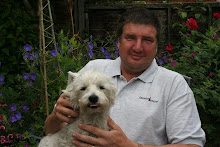A tiny amount of rain falls overnight; barely enough to lay the 'dusht'. Everything is tinder-dry and the front pages of the Western Mail local newspaper are full of dramatic pictures of gorse fires raging across County Mayo. One report had that the local Fire Fighters had been called out to 200 fires in the last few days. Our own measure of how dry we are is in this picture of strip-grazing on the front lawn, rabbit-style. These runs are moved every day, 24 hours being enough time for the rabbits to annihilate the grass in the run, so as you look from camera towards the runs you are looking at grass recovery growth per day, the nearest patch having had about 11 days to recover. You can see that the turf is still bald and not a cm of grass has grown in the 11 days, and this in Country Roscommon in Ireland's allegedly wet 'wesht' in March and April.
It's so dry that all the farmers are looking to let their cattle out of the indoor yards but they daren't as there is nothing for them to eat out there. I noticed on my dog walk today that even the ferns in the ditches and hedge-bottoms along the lane have that curled, frazzled, freeze-dried look. Liz and I are both wary of praying for rain as we might bring down another year like 2012 (!) but the garden could definitely use some.
'Hearth and Home' - now there is a nice, comforting expression evocative of the centre of a house, a focus for all the family activity. You'd think then that it would be one of the bits you'd be sure to finish as you completed a rebuild. It was certainly one of the first jobs I wanted to do as soon as we got hold of the house keys in December 2011 and readers may recall the fun we had, just newly in through the door, raking out old jackdaw nests, sweeping out the chimneys and cleaning up so that we could light fires in the old Rayburn range and the fireplace in the Living Room. We lit fires pretty much every day from then till our demolition work got to the stage of ripping out the Rayburn and CAREFULLY dismantling the fire place. We even apologised to the house as we drove away each Friday, for not being able to light fires on Saturday and Sunday. It was an important (and successful) part of trying to get some warmth into the house structure and dry it out.
It is, as well, a particularly fine fireplace. The locals think it was way too 'posh' to have been installed as original and must have been added later when the family got affluent. It was in a sorry state, falling away from the wall and with some sections broken. The copper hood, you may recall, was so black and tarnished that we thought it must be iron and in need of black-lead; luckily spotting a slight glint of shine and then getting some good advice from Mazy-Lou involving tomato ketchup as a cleaning chemical.
But we never quite worked out what to do with the hearth once it had all been carefully cleaned and re-hung. We weighed up a number of options involving a marble plinth and brass fenders, or simple dark tiles, but the stone was likely to be in the €200's and the fender another €250. We have sat there, indecisively, looking at the gap in the sandstone coloured floor tiles and found lots of other jobs to do instead!
Well, not any more. When helping John Deere Bob do his turf we spotted a big pile of old waste tiles including some marble-effect black floor tiles in the barn and Bob was more than happy to unload some on us, they having been gathered by one of his brothers while he was still living in the family home, where Bob now lives. He did not know where the brother had got them or why. Armed with a dozen of those and an angle grinder borrowed from Mentor Anne, and a bag of left-over floor tile adhesive, I was away and in just a few hours had created this hearth which we are both very pleased with. It looks very 'right' in our opinion, with the greener, multi-hued marble of the fireplace itself.
Meanwhile, I chug on with digging the pond, rather enjoying the dryness of the soil. The soil is light to lift by the shovel full and easy to walk around on being dusty rather than claggy, and smearing. I do this at about an hour a day, which translates into about 20 barrow loads. I hear all the comments about hiring mini diggers etc but I ignore them. We are time-rich and (comparatively) money-thrifty and, anyway, I LIKE digging. The thought of getting to the end of this project and being able to look out over the water and say "I dug all that by hand!" is an attractive one. It might take me weeks rather than the half a day of a digger, but we are not in any hurry. I do the hour as a 'constitutional', paying my dues, if you like, earning the right to do the easier, more popular jobs. That's just me.
I have, though, discovered how the French game of 'boules' or 'petanque' came to be invented. There was this gang of rural French villagers back in the day, named Etienne, Noel, Pierre, Thierry, André and Ullyse, who sat around the village pump smoking Gauloises and taking the Micky out of the village idiot who was stone deaf. He was so deaf that when asked anything, including his name, his reply was invariably, "Quoi"? and this became his nickname. So well ingrained did the nickname become that no-one could remember his proper name. Growing bored one summer of hanging round the village pump, this bunch of lads decided to go on holiday to Ireland where their long lost Auntie Elize had started to create a small holding in the 'wesht'. The lads' Mums insisted that if they were going, then they should a) take the idiot 'Quoi' with them and b) help Elize as much as possible on the 'farm'.
Well, as it happened, the job that week was to dig a big pond (wouldn't you know it?) so the lads pitched in and started to dig across the chosen space, digging up along the way, all manner of rocks, mainly hard sandstone lumps roughly round in shape and cricket ball sized. To start with the lads piled these in a heap, knowing that Elize might use them as path edges, but as they progressed backwards across the pond, away from their pile of stones, getting stones to the pile involved an under-arm toss of ever-increasing length. Get it right and your new stone clonked nicely into the pile and stayed there. Get it wrong and your stone bounced off one of the existing stones and shot off several yards across the grass and someone had to go retrieve it. Guess who? Quoi of course!
As the distance became greater, there was a real skill in making the correct toss and the lads, being a bit sporty enjoyed the competition with each other, cheering a good throw, laughing roundly at a bad one and even keeping score. The work progressed well and the pond was dug in no time, but the lads had enjoyed the throwing game so much they decided that a sport along the same lines should exist and that they'd take it back to their village and start it there. What to call it, then? Well, suggested Elize, let's make up a word which sounds like a lump of sandstone hitting the pile of stones, but the word be made up from all our names, P for Pierre, E for Etienne, T for Thierry and so on, with a Q for Quoi, of course and an E for their dear Tante Elize.
Or does that sound like a load of 'Boules' to you?
Wednesday, 10 April 2013
Hearth and Home
Labels:
Boules,
Elize,
Fire Fighters,
Gauloises,
Petanque,
Rayburn,
Roscommon,
Western Mail
Subscribe to:
Post Comments (Atom)






1 comment:
Loving the fire place, but thinking you have way too much time on your hands.
But do you not think it might be natures way of letting you dig the pond with all this dry weather, she knows it is easier when not so wet, just a thought, which no doubt you have already had
Post a Comment